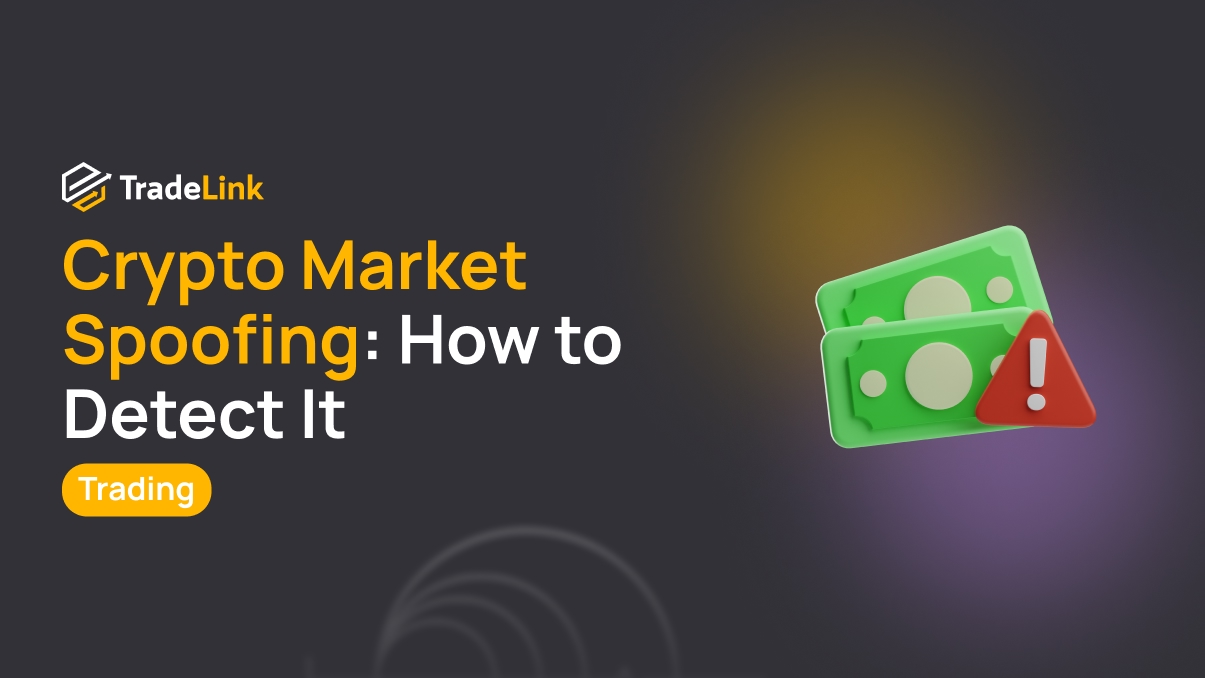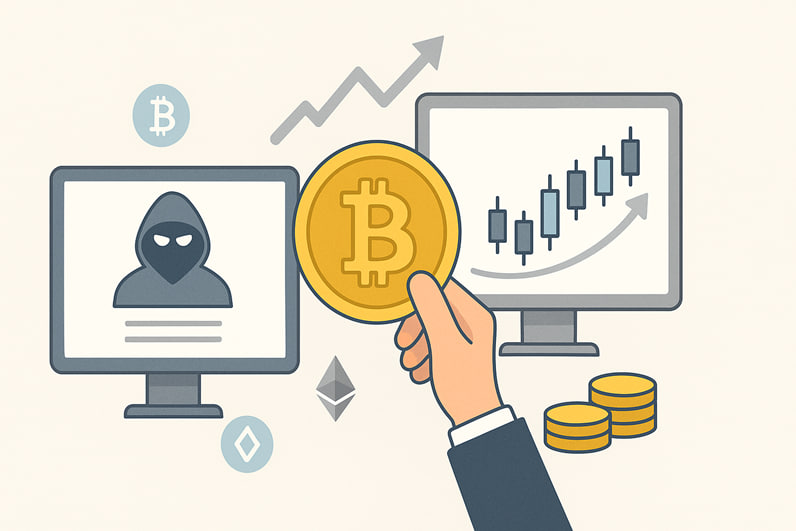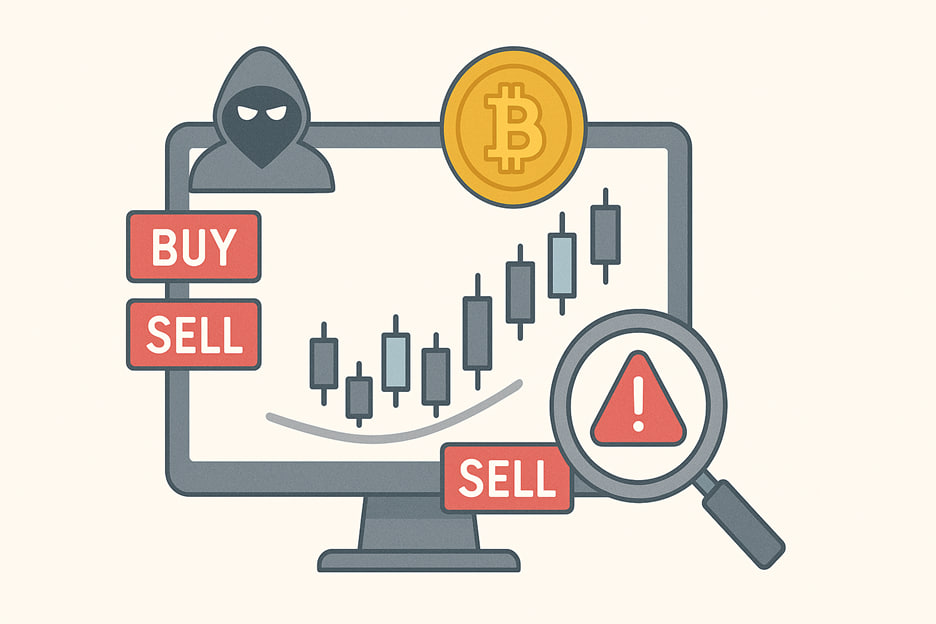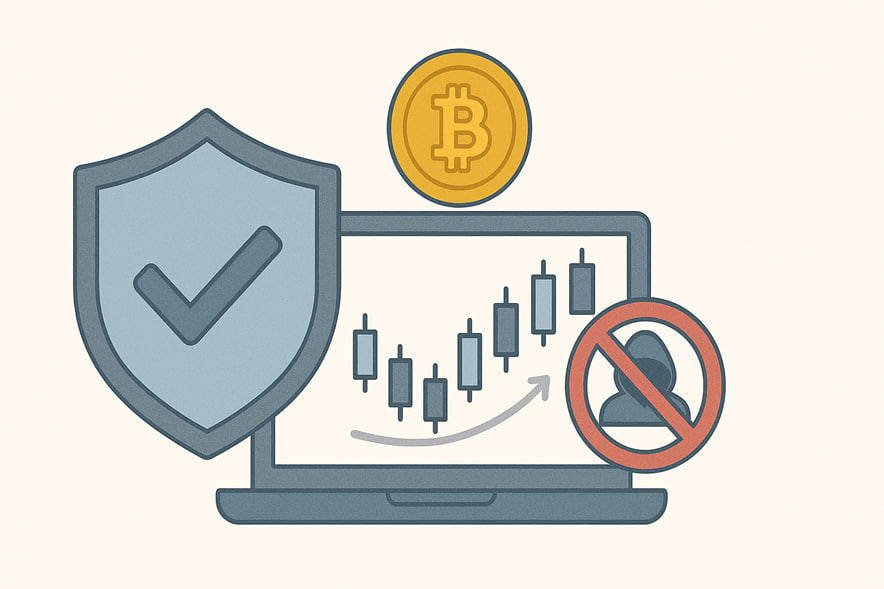Crypto Market Spoofing: How to Detect and Protect Your Funds

Contents
- Introduction
- What Is Spoofing
- Why Spoofing Is Common in Crypto
- Signs of Spoofing
- How to Avoid Spoofing
- Examples of Spoofing in the Crypto Market
- Conclusion
Introduction
Millions of transactions occur daily on the cryptocurrency market, and many traders aim to profit from price movements. But not everyone plays fair. Some use tactics that distort the market picture, such as spoofing.
This technique artificially alters market sentiment, causing traders to make wrong decisions and lose money. That’s why it’s essential to understand how spoofing works and how to spot it. Recognizing such schemes helps traders trade more safely and avoid falling for fraud.
What Is Spoofing

Spoofing is a form of market manipulation. It involves placing fake buy or sell orders, which are not meant to be executed. The manipulator sends a signal, as if someone intends to buy or sell a significant amount. In reality, the goal is to mislead others.
Spoofing occurs on traditional stock markets and crypto exchanges. It’s perilous on low-liquidity pairs, where even slight pressure can move prices sharply.
How Spoofing Works
Spoofing starts with placing a large order in the order book. For example, someone places a big buy order. Everyone sees that someone wants to buy many coins, creating a sense of strong demand.
But that order is fake. It’s not intended for execution. A second or two later, it’s withdrawn. Meanwhile, other market participants may already have reacted. They believe the demand is real and start buying, increasing the price.
At that moment, the manipulator sells their coins profitably and cancels the spoof order. Sometimes it’s the opposite: a large fake sell order triggers panic, letting the manipulator buy cheaper.
Spoofing vs. Other Manipulation Tactics
There are many ways to influence prices in the crypto market. Each works differently, but they all share the same goal — to confuse other traders and make a profit. Let’s compare them in the table below to understand better how spoofing differs from different methods.
Manipulation Type | Core Action | Does the Actual Trade occur? | Main Goal | How It Appears |
Spoofing | Fake orders with no intent to execute | ❌ No | Influence price and behavior | A large order that quickly disappears |
Wash Trading | Buying and selling the same asset to oneself | ✅ Yes | Create an illusion of demand and volume | Active trades without real buyers |
Pump-and-Dump | Artificial hype followed by a quick sell-off | ✅ Yes | Sharp price rise, profit-taking | Sudden spike followed by crash |
Layering | Placing several fake orders near the price level | ❌ No | Apply price pressure without real trades | Ladder of non-executed orders |
Spoofing is not just deception — it’s a psychological trick. It doesn’t require real trades and can quickly alter market perception. Unlike other tactics, it often leaves no clear trace.
Why Spoofing Is Common in Crypto
Crypto markets are less regulated than traditional ones. This makes it easier for bad actors to use deceptive strategies.
Cryptocurrencies are highly volatile — even small actions can move prices dramatically. Manipulators take advantage by placing fake orders, knowing the market will react quickly.
Role of Large Players
“Whales” — large traders or funds — play a special role. They have access to significant capital and can pressure prices without executing trades. Their goal is not just to profit from movements, but to steer the market and exploit others’ reactions.
They act cautiously and understand trader psychology. A fake large order can suggest a big move is coming, prompting others to take action. Whales are already prepared for the next step.
Spoofing may not be their main strategy but part of a broader plan, like accumulating assets at low prices or quietly exiting positions.
Regular traders often fail to notice the manipulation and lose money, while whales profit. Their actions require special attention and careful analysis.
Regulation and Spoofing Prevention
Some exchanges take spoofing seriously. Platforms like Binance, Bybit, and others have introduced measures to combat it. They monitor suspicious activity and block accounts if foul play is detected.
Still, spoofing remains hard to eliminate. It happens in seconds. Fraudsters use bots that place and cancel orders within milliseconds. Security systems don’t always keep up. Even automated filters struggle to distinguish between real and spoofed orders, especially when bots mimic standard trading patterns.
Signs of Spoofing

Traders can detect spoofing by watching the order book closely. Red flags include:
-
A huge order suddenly appears and stands out.
-
The order is near the market price but never filled.
-
It disappears within seconds.
-
The price moves in the direction the fake order suggested.
Also, unexplained rapid price spikes that repeat may indicate manipulation.
Tools for Detection
Useful tools include:
-
DOM (Depth of Market) — shows the order book and distribution of buy/sell orders. A heavy imbalance may signal spoofing.
-
Volume analysis — if trading volume surges without a price change, someone may be trying to move the market without real trades.
Some exchanges provide advanced analytics. There are also third-party platforms that scan multiple exchanges.
How to Avoid Spoofing

A trader may not notice spoofing right away. But there are simple rules that help reduce the risks.
-
Choose a reliable exchange. A good platform monitors the market and can quickly detect suspicious behavior. On such exchanges, the chances of encountering fraudsters are lower. It is better to use platforms with a good reputation and transparent trading conditions.
-
Use limit orders. Market orders are executed immediately and often at an unfavorable price. Limit orders allow you to set the price manually, giving you more control and helping you avoid traps created by spoofers.
-
Monitor the movement in the order book. If strange orders appear in the list and quickly disappear, it may be a sign of manipulation. It’s better to pause and not rush into a decision.
Asset Security
Even if traders don’t fall for spoofing, they can lose funds due to inattention. That’s why it’s important to follow basic security rules.
The most reliable way to store cryptocurrency is in cold wallets. These are devices that are not connected to the internet. A hacker cannot access them remotely.
Enabling two-factor authentication on all accounts is also worth it. This provides an additional layer of protection. If someone learns your password, they can’t log in without the second code.
And finally, don’t trade on unfamiliar websites and don’t click suspicious links. Many people lose money due to phishing and fake platforms.
Trading Strategies
To reduce the influence of spoofing, it’s better to choose a calm trading approach, such as long-term investments. Short-term fluctuations and false signals are less significant if the goal is to hold assets for years.
Diversification is another way of protecting. If funds are invested in different coins, one drop will not cause significant damage. At the same time, it is essential to study each project before buying it.
It’s not worth engaging in high-frequency trading without special equipment and knowledge. Such strategies require speed and precision. Spoofers are most active in this area, and the average trader almost always loses.
Examples of Spoofing in the Crypto Market
On the Binance exchange on April 14, a large sell order was placed — 2,500 BTC (about $212 million) for $85,600, which was 2–3% above the market level. The Bitcoin price responded by rising toward that level, until the platform removed the order, almost immediately after it was placed. After that, the price rolled back, and many traders were left at a loss, having bought on a false signal of growth.
Similar cases have also occurred: traders observed identical large orders appearing and disappearing every few minutes. After complaints about such actions, some exchanges investigated and temporarily blocked suspicious accounts.
This behavior shows the importance of treating sharp changes in the order book with caution. You should not make decisions just because a large order is visible. Before acting, it’s better to wait for confirmed movements — for example, actual execution of the order or additional activity around it.
Conclusion
Spoofing is not uncommon in the cryptocurrency market. It can confuse even an experienced trader. But knowing how this scheme works makes it easier to recognize and avoid.
It’s necessary to choose reliable exchanges, use limit orders, and not rush into buying or selling. It’s also essential to protect your assets and not trust unfamiliar websites.
The key is not to act under emotional pressure. It’s better to study the market and strategies than lose money due to someone else’s manipulation. The more knowledge a trader has, the higher the chances of preserving and growing capital.